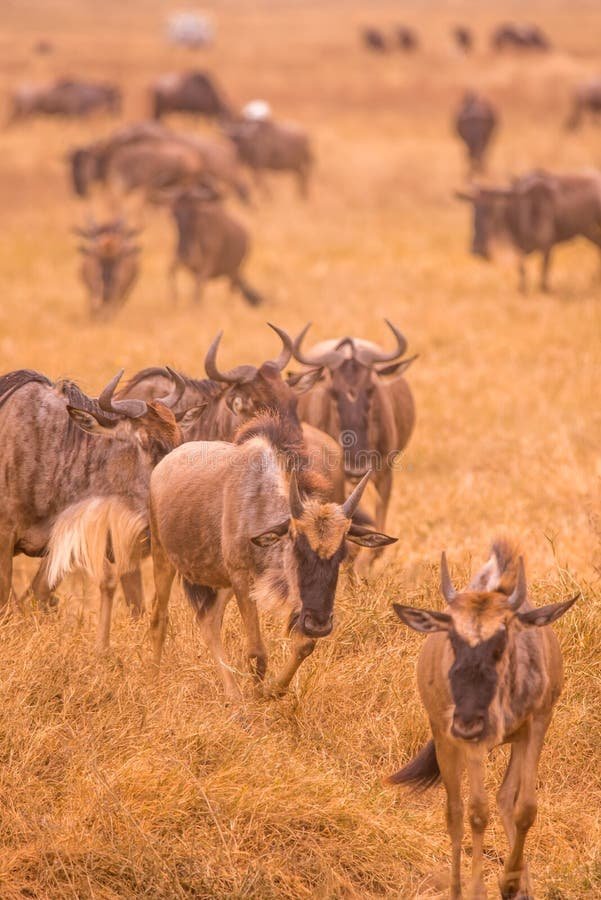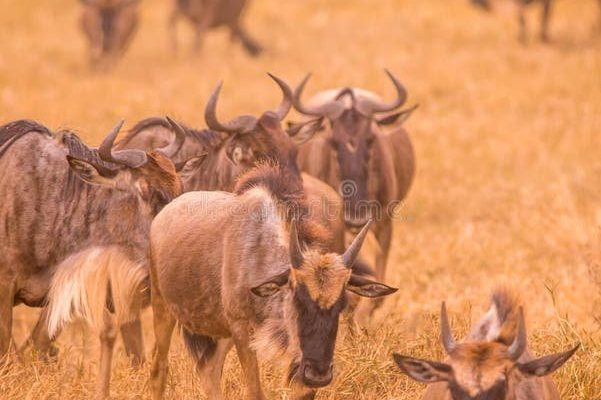
To understand the gnus’ survival strategies, we need to dive into their lives and see how they tackle the challenges that come with their rugged habitat. Think of it as a guided tour through the savannah, where the gnu is both the tour guide and the star of the show. From their unique social behavior to their impressive migration patterns, these animals have developed some fascinating methods to beat the odds.
Adaptations to Climate
Gnus are masters of adaptation. Living in regions where the weather can swing from scorching heat to sudden downpours, they have evolved to withstand a range of climate challenges. One key adaptation is their thick hide. This isn’t just for show; it helps protect them from the sun’s rays and prevents dehydration. Imagine wearing a natural sunscreen!
Moreover, gnu’s body is designed for movement. Their long legs let them cover great distances in search of food and water. This is crucial when food becomes scarce during dry spells. When other animals struggle, gnu can trek to areas where grass is still plentiful. And here’s a fun fact: gnus can actually go without water for days, relying on moisture from the grasses they consume.
Social Structure and Safety in Numbers
The social behavior of gnus is another fascinating aspect of their survival. These animals typically gather in large herds, sometimes numbering in the thousands. Living in a group has its perks. For one, safety in numbers makes it harder for predators—like lions and hyenas—to target individuals. It’s a bit like that old adage about the best defense being a good offense; by sticking together, they keep an eye out for threats.
Inside these herds, there’s a complex social structure. Younger gnus learn from older, wiser members. You might even see a mother leading her calf through the herd, teaching it the ropes. When danger looms, the herd reacts as one, often running in a zigzag pattern to confuse predators. This group behavior is an essential survival tactic that showcases their ability to adapt through social learning.
The Great Migration: A Journey of Survival
One of the most remarkable survival strategies of gnu is the Great Migration, a breathtaking journey that occurs each year across East Africa. Imagine thousands of gnus moving in search of fresh pastures, crossing rivers and plains while facing numerous hazards along the way. This migration is not just a quest for food—it’s a vital part of their life cycle.
During this journey, the gnus face numerous challenges, including crocodiles lurking in waters they must cross and the threat from predators following closely behind. Despite the dangers, this migration helps ensure their survival, as the constant movement allows them access to nutritious grass and water year-round. It’s nature’s way of keeping a balance, ensuring that the ecosystem remains vibrant and healthy.
Nourishment from the Land
Gnus are herbivores, primarily feeding on grasses. However, they’re picky eaters, preferring fresh, tender shoots—think of it as a buffet of soft green delicacies! But in a harsh environment where resources are limited, how do they find enough food?
The secret lies in their ability to roam. Gnus often graze in different areas, rotating among pastures to allow them to recover. This strategy not only helps them stay nourished but also ensures that they don’t degrade their environment. Grazing responsibly is essential for their survival, as it supports the ecosystem around them and allows grasslands to flourish.
Resilience Against Predators
Living in the heart of the African savannah means that gnus are constantly on the lookout for predators. Their survival depends significantly on how well they can evade dangers. Besides their herd behavior, gnus have developed other tactics. For instance, they have excellent eyesight and can pick up on the slightest movement in their surroundings.
When a predator is spotted, a gnu doesn’t just run blindly. They often stand their ground for a moment, assessing the threat. It’s a game of strategy; sometimes, they’ll run, and other times, they’ll stay still to avoid alarming the rest of the herd.
Let’s not forget about camouflage. Their dark, shaggy fur helps them blend into the environment, making it more challenging for predators to spot them, especially when they are lying down in the tall grass.
Gnus exemplify resilience in action. Their adaptations, social structures, and migratory behaviors all contribute to their ability to thrive in some of the harshest environments on the planet. By working together and responding to the challenges of their surroundings, they not only survive but play a vital role in the ecosystem.
So, the next time you hear about gnus in documentaries or articles, remember that they’re not just another animal in the wild—they’re living proof of nature’s incredible balancing act. They inspire us to adapt, learn, and work together, no matter how tough life gets. Whether it’s through their remarkable migration or their instinctive herd behavior, gnus remind us that survival is truly a team effort in the wild.

